Megan Dunn – 19 December, 2011
The viewer is greeted by Tony Fomison's bookshelf which reads like a Victorian antique. I gazed at the spines and they seemed full of romance, like the grandiose graves in an aging cemetery. I had no desire to read any; thought, like people is not eternal and even the most popular ideas of a generation are prone to fading into obscurity.
Wellington
Group show
Prospect: New Zealand Art Now
Curated by Kate Montgomery
26 November - 12 February 2011
Upstairs at Prospect the mood is more somber, there’s a feeling of density in the space that comes partly from the fact that the floor has been painted black. The viewer is greeted first by Tony Fomison’s bookshelf. If you don’t know who Fomison is it doesn’t matter. The bookshelf reads like a Victorian antique, a continuation of the elegy for the death of printed media, begun by Fiona Connor’s empty news stands downstairs. I gazed at the book spines and they seemed full of romance, like the decaying grandiose graves in an aging cemetery. I had no desire to read any of the books; thought, like people is not eternal and even the most popular ideas of a generation are prone to fading into obscurity.
I loved the pop-cultural gist of Robert Hood’s Teleplasmic Mass, a series of album covers and posters of ‘celebrities’ with plastic bags bursting from their orifices like bubble gum. The sense of the abject is strong in these collages. Snoop Dog and Kurt Cobain have white fabric running from their nostrils, at first glance I thought it was loo paper. The works in Teleplasmic Mass reminded me of Judy Darragh’s cum-paintings, drizzles of twink cascading down the faces, breasts and bonnets of cars and children in appropriated Kitsch posters. Yet Hood’s works were also a surprise; the subject of each work is smothered by plastic as if engulfed by the blob - an invasion of the abstract. The Pak ‘n’ Save bags and billowing fabric are sealed into each collage by another sheath of clear plastic. These 2D pictures bulge from the wall, carrying extra flab.
I noticed Robert Hood was born the same year as me and wondered if that helped me share in his particular web of signs. Hood has several works in the show, including Fomison’s bookcase. The Wrecked Kilometer is consummately displayed in its own discreet room. The viewer looks out across the busted and forked shards of white and red road markers but is not able to cross ‘the room’ to the other side. I imagine most people can form some kind of relationship with this installation even if it’s just thinking about the road toll and what it means to be in ‘mantrol.’ However for those in the know the work is actually a subversion of Walter de Maria’s famous piece ‘The Broken Kilometer.’
Hood’s least substantial work in the exhibition 7 Ingots is no less obtuse and intriguing. These wall mounted oblong silver globs have a distinctively sci-fi tang, but are actually made of aluminum from the artist’s car. The wiki definition of Ingot is a material that is cast into a shape suitable for further processing. This is quite fitting as most of the work in Prospect requires a bit of further processing.
The art contains references that aren’t always apparent just by looking at the work on display. In the accompanying catalogue Beckett is linked to choreography, Virginia Woolf can be seen through a microfiche darkly, Buchanan’s Older Lovers etc is partly a rekindle of the relevance of artist Flora Scales, Selina Foote’s abstract paintings aren’t just examples of beige geometric loveliness on silk, they are also drawn from lines in the Te Papa collection. Do we need to know these references? Are we impoverished without them? These are basic questions, perhaps even base ones, and the answer will ultimately depend on the viewer.
Seymour’s Triptych Lumiere is large, stately, and impressive. In this space, the tall black framed works become the dark waters of a pond, the circles on the surface, ripples flowing out. This is a work only half glimpsed in the light, your own reflection looms large. The art itself can’t fully be seen. In the end this is intrinsic to its success.
Dane Mitchell has become a vaunted and defining artist of his generation so it’s no surprise to encounter his work in Prospect. Mitchell’s practice walks the tightrope between ‘something’ and ‘nothing’ - what you see isn’t always what you get. His most intriguing work on display is a row of glass aubergine-like (or phallic) sculptures sitting on a mirrored ledge. Each one is a kind of epitaph, containing the name of one of Mitchell’s ancestors. This is the perfect example of the abstract thought that permeates the show: a name, represented in a breath, contained in blown glass. There’s no way the viewer can know this or intuit it from the work, the content is at some fundamental level invisible.
Perhaps Mitchell is the invisible man? He began his career pilfering Gow Langsford’s rubbish, won the Waikato art award for showcasing the wrapping that contained the other entries and now presents us with the scent of the gallery. An empty glass case stands nearby, a circle cut out at face height. I watched a father lift up his daughter, she took a whiff. He put her back down and asked her what it smelt like. She shrugged. I thought it smelt vaguely like warm glass. I had expected this work to be a one-dimensional joke, playing out a variation of the existential question ‘what is the sound of one hand clapping?’ However, I actually found it inviting and of course the fabled scent is there, invisible, but present, omitting its indefinable aroma.
By contrast Spong’s video looks elegant and is. The display of this work is particularly sensitive to the content. The viewer enters the room from the back of the screen, as though coming in round the wings of the stage. On screen the solitary dancer is lit by the blaze of one glaring studio light, the film is shot in black and white, rich in profile and shadows. The viewer watches in silhouette as the dancer rehearses her moves. The female dancer comes with all sorts of cultural connotations, from Degas to Flashdance and more recently, Black Swan. In the catalogue this video is said to investigate the influence of Beckett’s novella ‘Company.’ I haven’t read ‘Company’ but Beckett’s most well known work ‘Waiting for Godot’ has some relevance to the overall experience of Prospect. We now live in a culture well aware that Godot is a no-show; sometimes there’s just isn’t any point in waiting for everything to make sense.
The elephant in the room is Jacqueline Fraser‘s bombastic video: The Making of the Pope of Greenwich Village. As someone at the opening said to me: ‘What the f*ck?’ What’s intriguing about this work is that we don’t expect it to come from an artist of a certain age. Yet why not? Set to Jay Z’s track: ‘I’ve got 99 problems but a bitch ain’t one…’ images pulsate on the wall, a square of the floor and a corner of the blacked out room, like a nightclub flickering with strobe lights. The projections aren’t in sync. The images are ripped from magazines, the flickering snapshot of a man’s pumped and brown chest has stayed with me! It’s hard to know how to read this video. Is it funny? It certainly didn’t remind me of The Pope of Greenwich Village, a film I’ve seen. Fraser is the ‘wildcard.’ Her video is most notable for revealing some of my own prejudices (and others) about which content belongs to which generation.
I’ve saved Simon Denny‘s work for last, because I think the video space at the entrance to the gallery is often bypassed There’s nothing anyone can do to change that (with the possible exception of Lady Gaga). Denny’s contribution to Prospect, Corporate Video Decisions and Diligent Boardbooks Embedded, didn’t hold my attention, it may partly have been the limbo-like space. The most memorable aspect of these videos is the irritating and piercing beep one emits at regular intervals, a chilling and intrusive sound. According to the catalogue ‘…Denny’s presentations point to powerful cultural forces in mid-swing and ask us to pay closer attention to the mediums of communication we might take for granted…’ That may be so but these videos are presented in the same way the news is played on an outdoor screen at a pub, the audience tuning in and out depending on what’s happening. As Samuel Beckett said: ‘Try again. Fail again, Fail better.’ Whether it is my failure or the failure of the piece isn’t really important.
Prospect delivers on its promise. Ultimately the artist’s first responsibility is to engage with their own work - and it’s clear these artists are pursuing the ideas that concern them right now. It’s an exhibition strong on symbol. We look at the art and wonder what it means. We attempt to extract the metaphor from each piece, yet this isn’t always easy, and perhaps it’s simply because art isn’t language. We try again, we fail again, we fail better.
Megan Dunn
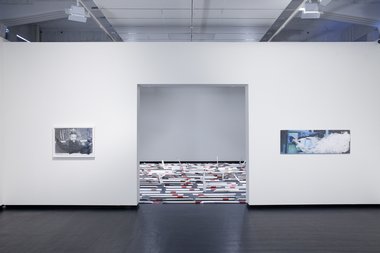
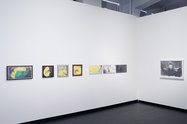
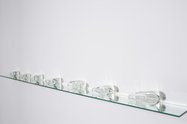
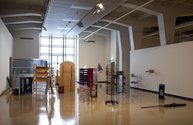





 Two Rooms presents a program of residencies and projects
Two Rooms presents a program of residencies and projects Advertising in this column
Advertising in this column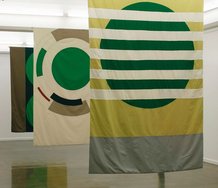
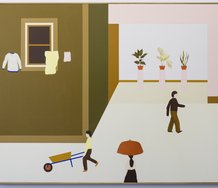
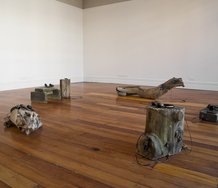
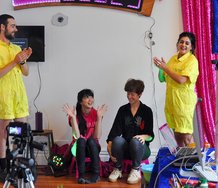
This Discussion has 0 comments.
Comment
Participate
Register to Participate.
Sign in
Sign in to an existing account.